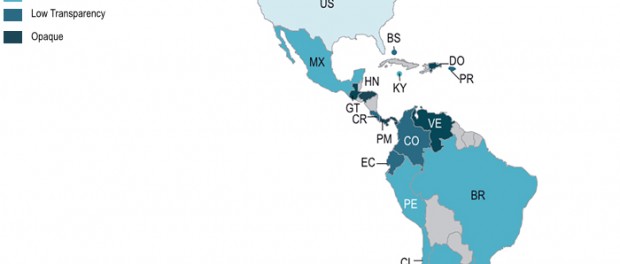Uruguay mantiene la calificación de baja transparencia (low transparency) en el informe sobre transacciones de inmuebles:
A highly divergent landscape of transparency
Real estate transparency across the Americas remains a very mixed picture, with a large degree of variation by country and sub-region, as well as by transparency category. In aggregate, transparency overall has been very stable in recent years, showing almost no region-wide momentum in either direction. In fact, a good deal of the scoring movement within individual countries has been driven by question refinements and the implementation of more precise scoring. Still, a closer look at the wide variety of transparency levels reveals a dynamic region full of challenges for market participants in terms of understanding, assessing and executing transactions, but also rife with opportunities to markedly improve and expand opportunities for investors, governments and corporate tenants alike.
Real Estate Transparency Index, 2016
Latin America lags in ‘Performance Measurement’ and ‘Market Fundamentals’
The Americas is in the middle of the pack globally and registers somewhat lower transparency than the globe overall. Continuing to pose the greatest challenges for most countries throughout Latin America and the Caribbean are very low transparency within the general categories of ‘Performance Measurement’ and ‘Market Fundamentals’ data. Unlisted fund indices are non-existent throughout the vast majority of the region; private investment returns data is in general very limited; and publicly-traded real estate firms in several countries are still overwhelmingly or even exclusively homebuilders and construction-focused companies – as opposed to ownership-focused commercial property firms.
Canada’s transparency boosted by better ‘Performance Measurement’
By contrast, some of the most transparent countries – at a global level – are growing even more transparent in terms of investment performance transparency. A prime example is Canada, where the transparency of privately-held fund performance has improved meaningfully. This has occurred as the IPD Canada Quarterly Property Fund Index has, in relatively short order, gone from its infancy just a few years ago to become a widely recognised industry benchmark in 2016. This area of improvement for Canada is one reason why it was able to essentially tie with the United States as the most transparent country in the region in 2016.
Brighter spots in the ‘Transaction Process’
Although there is clear room for further progress in most countries, better transparency can be found in the actual real estate ‘Transaction Process’. The availability and quality of pre-sale information, the fair, equitable and confidential nature of the bidding process, as well as the existence of and adherence to a real estate professional’s code of ethics all show at least reasonable transparency.
Performance is meaningfully more transparent in occupier management services. A standout showing here is Mexico, which scores highly transparent in areas like the knowledge of service providers, as well as exactly which facility or project management services they are supplying.
Mexico is Latin America’s most transparent market
Indeed, Mexico is Latin America’s most transparent market overall, with a score high enough to land near the top of the ‘Semi-Transparent’ tier. The country has a strong showing in transparency of the overall transaction processes, with fairly high scores in the transparency of sales transactions too. Other categories of clear strength can be found in the ‘Governance of Listed Vehicles’ (in which the FIBRA or Mexican REIT industry has blossomed from its inception just six years ago) as well as in the overall ‘Regulatory and Legal’ environment – although commercial property debt information is something of an exception. As in virtually all of Latin America, ample room for further transparency improvement exists in the areas of privately-held performance measurement and real estate market fundamentals data.
Fuente: http://www.jll.com/









Deja un comentario